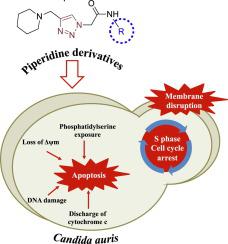Journal of Advanced Research ( IF 11.4 ) Pub Date : 2020-11-10 , DOI: 10.1016/j.jare.2020.11.002 Vartika Srivastava 1 , Mohmmad Younus Wani 2 , Abdullah Saad Al-Bogami 2 , Aijaz Ahmad 1, 3

|
Introduction: The fungal pathogen Candida auris, is a serious threat to public health and is associated with bloodstream infections causing high mortality particularly in patients with serious medical problems. As this pathogen is generally resistant to all the available classes of antifungals, there is a constant demand for novel antifungal drugs with new mechanisms of antifungal action.
Objective: Therefore, in this study we synthesised six novel piperidine based 1,2,3-triazolylacetamide derivatives (pta1-pta6) and tested their antifungal activity and mechanism of action against clinical C. auris isolates.
Methods: Antifungal susceptibility testing was done to estimate MIC values of piperidine derivatives following CLSI recommended guidelines. MUSE Cell Analyzer was used to check cell viability and cell cycle arrest in C. auris after exposure to piperidine derivatives using different kits. Additionally, fluorescence microscopy was done to check the effect of test compound on C. auris membrane integrity and related apoptotic assays were performed to confirm cellular apoptosis using different apoptosis markers.
Results: Out of the six derivatives; pta1, pta2 and pta3 showed highest active with MIC values from 0.24 to 0.97 μg/mL and MFC ranging from 0.97 to 3.9 μg/mL. Fungicidal behaviour of these compounds was confirmed by cell count and viability assay. Exposure to test compounds at sub-inhibitory and inhibitory concentrations resulted in disruption of C. auris plasma membrane. Further in-depth studies showed that these derivatives were able to induce apoptosis and cell cycle arrest in S-phase. Furthermore, the compounds demonstrated lower toxicity profile.
Conclusion: Present study suggests that the novel derivatives (pta1-pta3) induce apoptotic cell death and cell cycle arrest in C. auris and could be potential candidates against C. auris infections.
中文翻译:

基于哌啶的 1,2,3-三唑基乙酰胺衍生物诱导耳念珠菌细胞周期停滞和细胞凋亡
简介:真菌病原体耳念珠菌是对公众健康的严重威胁,并与血流感染有关,导致高死亡率,特别是在患有严重医疗问题的患者中。由于这种病原体通常对所有可用的抗真菌药物类别都有抗药性,因此对具有新的抗真菌作用机制的新型抗真菌药物有着持续的需求。
目的:因此,在本研究中,我们合成了六种基于哌啶的新型 1,2,3-三唑基乙酰胺衍生物 (pta1-pta6),并测试了它们对临床耳念珠菌分离株的抗真菌活性和作用机制。
方法:按照 CLSI 推荐的指南,进行抗真菌药敏试验以估计哌啶衍生物的 MIC 值。MUSE 细胞分析仪用于使用不同的试剂盒检查暴露于哌啶衍生物后耳念珠菌中的细胞活力和细胞周期停滞。此外,进行荧光显微镜检查以检查测试化合物对耳念珠菌膜完整性的影响,并进行相关的细胞凋亡测定以使用不同的细胞凋亡标记物确认细胞凋亡。
结果:在六个衍生品中;pta1、pta2 和 pta3 表现出最高的活性,MIC 值为 0.24 至 0.97 μg/mL,MFC 范围为 0.97 至 3.9 μg/mL。这些化合物的杀真菌行为通过细胞计数和活力测定得到证实。暴露于亚抑制和抑制浓度的测试化合物导致耳念珠菌质膜的破坏。进一步深入的研究表明,这些衍生物能够在S期诱导细胞凋亡和细胞周期停滞。此外,这些化合物表现出较低的毒性特征。
结论:目前的研究表明,新的衍生物 (pta1-pta3) 在 C. auris 中诱导凋亡细胞死亡和细胞周期停滞,并且可能是对抗C. auris感染的潜在候选者。











































 京公网安备 11010802027423号
京公网安备 11010802027423号